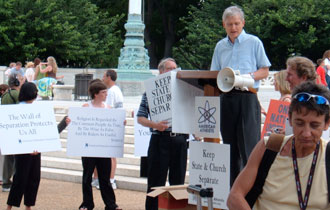The Abortion Issue Gets Sticky
21.07.05
 It’s a different world at midnight on the grounds around the Capitol. I trace Whitman’s steps beneath the harsh glare of the fluorescent lights, spying an occasional secretary or prostitute hurrying home, black eyes or busted lips half-hidden beneath bangs and attracting the jeers of the capitol police who sit idly at the checkpoints, including the motorcycle cops who unironically stride their Honda Rebels. Beneath the snipers posted on the roofs, cigar-smoke and laughter waft from the windows of the Senate buildings onto the streets below.
It’s a different world at midnight on the grounds around the Capitol. I trace Whitman’s steps beneath the harsh glare of the fluorescent lights, spying an occasional secretary or prostitute hurrying home, black eyes or busted lips half-hidden beneath bangs and attracting the jeers of the capitol police who sit idly at the checkpoints, including the motorcycle cops who unironically stride their Honda Rebels. Beneath the snipers posted on the roofs, cigar-smoke and laughter waft from the windows of the Senate buildings onto the streets below.
By day, these same streets are crowded with senators scrambling to photo-ops like satraps from early cinema, makeup running in rivulets down their creased cheeks. Each flits from building to building, surrounded by swarms of twenty-something drones wearing suits calibrated to political bent: dark blue or black (Republican) or khakis with studiously mismatched blazers (Democrat). Ambition and hypertension steam up from the sidewalk. Buses filled with retired Midwestern schoolteachers empty into their midst. Hands clasp and lips pull back into rictus smiles. Sartorial finery and flag pins alone separate the two species, the representative and the represented, both progressively endomorphic with age.
The masses swirl around socialist realist sculptures of horses and muscle-bound men, or fasces and figures of Roman allegories only dead Victorians would recognize. Carvings on their bases read “Where the law ends, tyranny begins” or “The heritage of the past brings forth the harvest of the future” and other once-inspiring apothegms.
On the summit of Capitol Hill stands the “highest court of the land,” a joke made by each tour guide in reference to the basketball court on the top floor of the Supreme Court. The building, completed in 1935, was tailored to former president and then-Chief Justice Taft’s demands for an edifice “of dignity and importance suitable for its use as [the Court’s] permanent home.” Walter Gropius was too busy fleeing from Nazis to submit a proposal, so the planners went with another young German who convinced them that the court should be built with an eye to the coming centuries, so that long after being abandoned its majestic ruins would stand, as glorious as those of the ancient Greeks and Romans, to awe future generations.
Taft, himself something of a visionary, foresaw an architectural scale commensurate with the diginity of his over three-hundred pound corpus juris, and demanded seventeen-foot high bronze doors and Brobdingnagian marble columns in the Corinthian style. Their acanthus leaves were to support a stone billboard reading “Equal Justice Under the Law.” It is often debated whether the redundancy or the sarcasm of this aphorism was responsible for the thunderous peals of laughter which often shook Taft’s jolly mass late into the night. Ever striving for allegorical critical mass, atop the architrave the builders placed a pediment where preside the personified figures of Law, Order, and Liberty.
A marble mannequin of Taft himself reclines at their feet. He is depicted as the young, shirtless and muscular student he probably was during his early days at Yale, before the long years of public service and sacrifice.
Behind the marble facade, the nine sedulous apes who sit inside the building form shifting phalanxes for or against the will of the majority, depending on one’s views, and their most controversial task involves stepping in and nationalizing certain hobbies (voting, the use of contraceptives, choices of sexual orientation or race of one’s mate, etc.) upon which the chicken farmers and high-school football coaches of the state legislatures cannot form a consensus. Sometimes they negate the national Solons’ equally erudite measures, such as tinkering with federal jurisdiction to double possible prison sentences for non-violent penal code infractions.
The constant construction from the capitol’s perennial post 9/11 refortification haunts the area with fumes from the sewers below. At various times the court grounds reek of ancient legal tomes and geriatric farts. On days when decisions are handed down the odor is unbearable, and the hot dog vendors move their stands over to the Library of Congress.
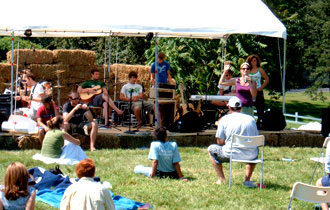 One afternoon as I hurriedly passed by I noticed a crowd of teens assembled in rows on the plaza in front of the court. Their noses were sensibly covered with tape. Several rhythmically rocked back and forth. Most wore clothes of the grunge style adopted by drug addicts or in the loose fitting fashion preferred by juvenile delinquents. I approached cautiously, mindful of Alabama Supreme Court Justice Johnstone’s observations:
One afternoon as I hurriedly passed by I noticed a crowd of teens assembled in rows on the plaza in front of the court. Their noses were sensibly covered with tape. Several rhythmically rocked back and forth. Most wore clothes of the grunge style adopted by drug addicts or in the loose fitting fashion preferred by juvenile delinquents. I approached cautiously, mindful of Alabama Supreme Court Justice Johnstone’s observations:
"An ubiquitous fad these days is baggy, oversized trousers, falling off the hips. The origin of this fad is the prison system, where prisoners are issued too-big trousers when trousers that fit are unavailable. A variation of this fad– baggy, long trunks– has spread to boxers and basketball players, local and national.
The originators of the fad were emulating their friends or role models who were prison inmates. To some extent, the young men who adopt or copy the fad are expressing the same admiration or alliance.
Will the prison population and its admirers and allies reach a critical mass? If so, what will happen?"
Had that dreaded moment come? Perhaps these youths were protesting some sumptuary act of Congress or court edict of which I was yet unaware. Drawing closer, I could see that the tape didn’t cover their noses but rather their mouths. On each strip the word “Life” was printed in marker.
I watched a group of elderly tourists pass and pause behind the kids. A college-aged girl in a stained muslin dress also noticed them and left her place in the line. The girl slowly removed the tribe’s oral adhesive, stuck it to her dress, and began to lecture the onlookers. She looked like someone at a show who’d pass you a joint, which you’d immediately hand back after catching the anger in her eyes.
Their group had come to Washington from Colorado Springs this past January, she explained. I recognized that as the Kandahar of Colorado, a state who presciently adopted as its official song a ditty entitled “Where the Columbines Grow.” I don’t know its history but most likely it predates the semi-eponymous Michael Moore film. Not only does Colorado Springs headquarter the Air Force Academy, which is the subject of an ongoing investigation concerning institutionally-sponsored Christian (hereafter “xian”) proselytizing, but the city is home to over 100 evangelical organizations, the largest being James Dobson’s Focus on the Family.
“We began with fifty days and nights of nonstop prayer before we headed to Washington,” she recited. “We come from all over the United States. God called us to Washington to reestablish the covenant that the United States government broke with the Native Americans, then the slaves, and now finally with the unborn.” She showed her teeth and laughed, looking like a chimpanzee guarding a banana. I watched as one couple nervously eyed each other, but most of the others laughed back. A few nodded.
I tuned out, more interested in the discussion between a man wearing a sandwich-board that read “Income Tax Is Illegal” and a fat man in a suit who was setting up a papier-mache replica of the Ten Commandments. It was the hottest day of the year, and the sweat from the fat man’s palms smeared the tablets’ faux-stone-finish. It had rubbed off in great gray streaks on the sleeves of his jacket. He leaned the prop against a short row of bushes, but the angle was too acute, the shrubs too spongy, and soon he had gray streaks on his pants as well. Income Tax Man advocated his more mobile technique and suggested strapping the tablets over the fat man’s shoulders. Fat Man glared back like he’d been offered a snake and sharply replied that he couldn’t split the tablets in two and that it was too hot to be walking around anyway. After a few more attempts he ended up laying the tablets on the plaza steps and sat down beside them in his ruined suit.
The sight-seeing senescents were growing restless, as though at some point in life they’d realized every word was just another pitch. They hadn’t come all the way to Washington to hear the same hooks and harangues which filled their mailboxes and telephones in Wichita; they’d come to marvel at the museums and monuments, to secretly wonder what faults and bad decisions had prevented their own rise to rule, and to be reminded of how soon they would be gone and forgotten. How small and insignificant their own brass or marble markers would compare.
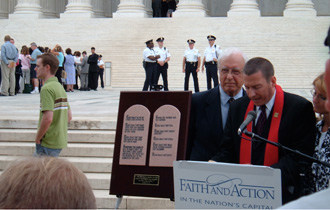 Sensing their impatience, the girl talked faster and concluded by telling them to check out her group’s website, bound4life.com, and asked them to order bracelets in show of their solidarity. I saw a few wrinkled jaws clench at that hated word “website,” that bitter foretaste of obsolescence.
Sensing their impatience, the girl talked faster and concluded by telling them to check out her group’s website, bound4life.com, and asked them to order bracelets in show of their solidarity. I saw a few wrinkled jaws clench at that hated word “website,” that bitter foretaste of obsolescence.
They filed away. The girl pulled the strip of tape off her dress, not noticing a coin fall out of her pocket and roll down the sidewalk. As she slapped the tape over her smile, the last of the group to leave, an old salt in a crisp new fishing vest, stepped over, carefully high-fived her, and said, “Keep up the good work.” She nodded and grunted two times for “ok.” Then she walked back and took her place among the others.
As I strolled off I bent over and picked up the coin. It was a Canadian quarter. I palmed it and kept walking.
Usually I find that it’s about as fulfilling to discuss abortion as it is to talk about UFOs or religion. Its mention triggers connotations of firebombings, assassinations, and yelling. Lots of yelling. When I hear zealots on either end of a subject it conjures up Kissinger’s comment about the war between Iran and Iraq: it’s a pity both sides can’t lose. To state the obvious, abortion’s a minefield of complex philosophical issues, yet somehow everyone from the plumber to the professor has it all figured out. On a personal level, it’s always a drag when a friend has to face that decision. You try your best to counsel them and provide comfort if they go through with it. I believe Catharine MacKinnon is about as rational as Robert Lowell, but I stand eye to eye with her claim that it’s a decision which only a pregnant woman can make, and the political status of the fetus would differ vastly if sexual equality existed socially. As she notes in “Women’s Lives, Men’s Laws,” until this happens, “abortion provides a window of relief in an unequal situation from which there is no exit.”
I went home and checked out the kids’ website. It had a Martin Luther King quote on the home page. I suppose he knew a thing or two about firebombings. The site had pictures of the kids, and a twenty-two word prayer which was supposed to be repeated five times a day. Weird, I thought. Five? Isn’t that the number of times a day Muslims are supposed to pray to Mecca?
I figured I’d walk back up to the court. It was a different, smaller group than the earlier one I left. Fat Man and Income Tax Guy were gone. It was just me and five teens mouths taped shut and bound for life. Just like old times. The only thing missing was a van, chainsaw, and contractor bags.
I smoked a cigarette and watched. After a few minutes one of the girls stepped back and headed towards a cooler.
“Hey,” I said. “You’re the group that says to pray, vote, and obey, right?” I thought that sounded better than, “You don’t really believe this shit, do you?”
Her brow unfurrowed and she walked over. We chatted for a half-hour.
The kids came to the city twice a day in shifts, according to her. One got there at twelve and the other at five. Their group stayed just outside the Beltway on a farm in Bowie, Maryland.
Bowie is to anti-abortionists what Coeur d’Alene, Idaho is to the Aryan Nations and Christian Identity movements. Michael Bray, the leader of the “Army of God,” founded the group in Bowie (small world—his son attends the Air Force Academy in Colorado Springs!). Bray was the author of “A Time to Kill,” a situationist detournement of the John Grisham novel by the same title. However, Bray’s version is a bit shorter on plot, longer on biblical quotes, and decidedly unimaginative regarding the fate of health-care workers whose careers are even tangentially traceable to women’s clinics. Although arguably parody, Bray’s artsy antics proved too much for the stodgy bourgeois establishment, which in the mid-80’s sent him to prison, specifically for a number of conspiracies to firebomb women’s clinics and the Washington office of the ACLU.
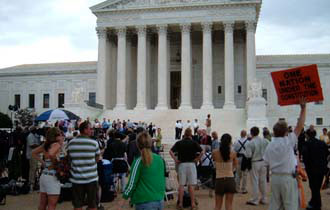 Bray’s troupe had also jokingly criticized– some would say threatened with death– Harry Blackmun. The apparently humorless Blackmun was a reclusive Washingtonian “writer’s writer” whose essays, despite being most charitably described as dry, have sparked widespread attention far beyond his adopted hometown. His most widely recognized work, “Roe versus Wade,” received a lukewarm response from the public at the time of its publication. It was also uncontroversial among his cabal of six co-authors: its two dissenters were Byron White and an Andre Breton-like figure named William Rehnquist who would subsequently ascend to the group’s leadership. Nonetheless, in the three decades since its release, “Roe” has created innumerable careers, cottage industries, mountains of secondary literature and critical reviews, along with a number of lesser-known sequels. It has also made a lot of people mad as hell, whose rage oddly is often in inverse proportion to their likelihood of ever relying upon, or actually reading, the piece.
Bray’s troupe had also jokingly criticized– some would say threatened with death– Harry Blackmun. The apparently humorless Blackmun was a reclusive Washingtonian “writer’s writer” whose essays, despite being most charitably described as dry, have sparked widespread attention far beyond his adopted hometown. His most widely recognized work, “Roe versus Wade,” received a lukewarm response from the public at the time of its publication. It was also uncontroversial among his cabal of six co-authors: its two dissenters were Byron White and an Andre Breton-like figure named William Rehnquist who would subsequently ascend to the group’s leadership. Nonetheless, in the three decades since its release, “Roe” has created innumerable careers, cottage industries, mountains of secondary literature and critical reviews, along with a number of lesser-known sequels. It has also made a lot of people mad as hell, whose rage oddly is often in inverse proportion to their likelihood of ever relying upon, or actually reading, the piece.
But this girl lacked the anger and intensity of the earlier spokeswoman. “Our leadership at the farm is much older. Praise God for them. They’re awesome. God placed this task on our heart and many of us left college to come here.”
I offered her a cigarette. I would have been surprised if she accepted it, but she didn’t.
“How long do you expect to be here? You know the Supreme Court term’s about to end? They have the first abortion case in five years on the next docket.”
She admitted she didn’t know the current term was about to end, or that there was an upcoming abortion case. No big deal; when I was her age if Naked Raygun sang that Reagan was about to draft me to fight in Nicaragua, I could hate him without too much concern for the details. Then again, I didn’t drive across country to stand in front of his house every day, either.
What the girl did know for certain was that they would stand there until Roe was overturned.
I asked her how she became so ambitious.
God told her to come to Washington, she said; he’d placed the issue on her heart and the injustice against newborns [sic] weighed heavily on her. God also had convinced her parents to finance her mission.
At several points I inquired about religious denomination: her family’s, hers, and that of the group. Each time she vaguely answered that they all were non-denominational, that they were just xian.
“Any Catholics in your group?” I asked.
“No, but we pray for them too; prayer can touch anyone.”
This clarified my confusion. The two most conservative members of the court, both Catholic, would be relieved to know that at least there were no hard feelings for their faith’s love of a good practical joke. Sure, the Inquisition, St. Bartholomew’s Day Massacre, the whole Galileo and anti-Semitism things got a little out of hand. But that’s ancient history. They were much younger then; frat boy pranks really. The 1933 Concordat with Nazi Germany? C’mon, who hasn’t signed something without reading the fine print. Particularly after reading the Bible by candle the night before.
The girl went on to correct my misconception that the rocking engaged in by the kids was some form of the moshing which lately I had heard so much about. She explained that it was simply a habit which eased the long hours of standing. Occasionally, she added, they stand there for twenty-four hours straight.
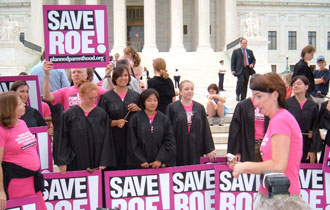 “But why?” I pleaded. “You’re a bunch of college kids. You should be getting fucked up, fucking, and fighting the man, i.e. your parents. Which I guess you’re sort of doing by fighting potential parents. Ok, if the Supreme Court isn’t the man, who is? I’ll give you that. Seriously, can you believe that medical marijuana decision? Written by the quote-unquote most liberal justice? But wait, it’s the liberal justice that also voted to ban flag-burning. All I know is that Scalia’s prized consistency must have woken up the next morning and said ‘I did what to states’ rights? With who? Oh, Jesus. Goddamit, gimme some aspirin. At least tell me some San Franciscans got the worst of it. Cool. How much do you want for those poloroids? By the way, those liberal justices sure know how to party!’”
“But why?” I pleaded. “You’re a bunch of college kids. You should be getting fucked up, fucking, and fighting the man, i.e. your parents. Which I guess you’re sort of doing by fighting potential parents. Ok, if the Supreme Court isn’t the man, who is? I’ll give you that. Seriously, can you believe that medical marijuana decision? Written by the quote-unquote most liberal justice? But wait, it’s the liberal justice that also voted to ban flag-burning. All I know is that Scalia’s prized consistency must have woken up the next morning and said ‘I did what to states’ rights? With who? Oh, Jesus. Goddamit, gimme some aspirin. At least tell me some San Franciscans got the worst of it. Cool. How much do you want for those poloroids? By the way, those liberal justices sure know how to party!’”
Thankfully I only said the first two words aloud. While I was thinking the rest the girl said something about Jesus this, Jesus that, and by the time I was paying attention again she was going on about a nation crumbling without justice, that the nation has to reestablish the culture of life which begins with a legal decree to break the covenant with death. They went to Florida for Terri Schiavo but were glad to get back to the wall.
“The wall?” I stubbed my cigarette out. A guard was eyeing me so I put the butt in my pocket.
“It’s from Ezekiel. We’re here manning the wall in order to keep injustice from getting in or out of the court building.”
I thought she said “a justice” instead of “injustice” and was shocked. When I realized what she really had said I became even more mystified.
“Your group also protests abortion clinics, right? I saw that on your website.”
“Yes, but we’re nonviolent. The Ten Commandments say don’t murder so none of us has ever done that. We pray at the clinics for mercy.” Her speech slowed the more metaphysical and less factual its content. “We’re crying out for mercy, mercy even for the abortionists so that they would have the revelation of God’s love for them. Saul killed xians and then he was converted, so anyone can be changed. Just like God changed me. We’re all born into sin. We can’t walk righteously. We’re in need of a savior. It’s just… it’s just about loving Jesus.”
She sounded frustrated. Rather than offer any personal speculations about sin, redemption, or monotheism in general, I changed the subject.
“You heard they busted a Texas death penalty case today?” I said, hoping I’d found safer water.
She hadn’t.
“Well,” I went on, “what do you think about the death penalty?”
She chewed her lip like she’d never thought about it. As the silence stretched I pulled out and lit another cigarette.
Nobody said anything.
“An eye for an eye?” I finally offered.
“Yea, an eye for an eye. Our group doesn’t take a position on it, you know. But,” she said, narrowing her eyes, “crime cannot go unpunished. We’re in a dangerous position right now. The signs are all there, the same ones that preceded Hitler and the Holocaust.”
“Huh,” I replied. “That Hitler sure was a rascal.”
“Yea, so anyway, we’re having a forty-eight hour prayerathon this weekend at the farm. Get directions off our website if you want to come. I should get back to the wall.”
I agreed and walked off.
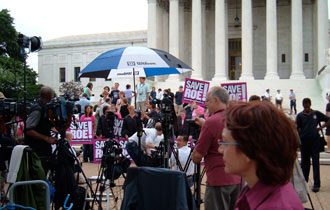 Later it struck me that I should have followed up on what she meant by the word “crime.”
Later it struck me that I should have followed up on what she meant by the word “crime.”
This, in a nutshell, is why I make a poor journalist. As I see it, the essence of good reportage is the ability to pose those tough questions, like what if you and a pregnant woman are stuck out at sea in a lifeboat? Both of you will survive only if you abort the baby and eat it. The lady refuses to abort it herself. You could kill her and eat both her and the baby. That leaves one person alive. All you know for sure is that there’s no way you’ll let yourself starve even if you aren’t religious, and no way if you are because that’s suicide and a straight ticket to hell. Oh, you additionally know that the baby is the embryonic Hitler and will grow up to kill millions. What do you do?
That’s what I should have asked her. Perhaps she would know of some “greater good” exception to the religious “no suicide” rule; there must be one because if Jesus knew he was going to get killed and let it happen anyway that sounds like suicide to me. Suicide by cop, or cross in this case. Not being an xian myself, I don’t have standing to criticize their religion without sounding like some sort of Enlightenment imperialist. Nonetheless, I made a mental note to pose these difficult questions at the weekend’s prayerathon.
Back home I confirmed my poor cross-examination. I checked out a number of anti-abortion websites (there are quite a few, darn those computer-savvy creationists!) and learned that many of the groups call the murder of doctors, judges, or anyone who facilitates an abortion self-defense. A cavil: to assume for argument their reasoning, it would more appropriately be called defense of a third person, unless the embryo itself was the killer. Putting such horrifying images aside, however, the bottom line is that there are a whole lot of people who believe that killing over abortion is justified. No murder, no crime.
Similarly, I discovered a rich debate within anti-abortion circles about the death penalty. I credulously assumed “pro-life” and “pro-death” were irreconcilable positions. I really didn’t, but sometimes I can spot a contradiction if it’s as big as the Hindenburg and red as a baboon’s ass. Yet my research showed that the anti-abortionists were relatively untroubled by this potential disconnect. These people advocate killing, after all.
For instance, Paul Hill, whose hagiographies filled several websites, killed a doctor and his assistant and wounded a nurse in the parking lot of a Florida abortion clinic (ironically, the doctor was filling in for one who had been killed by another anti-abortionist). First question: was this a crime? Florida answered affirmatively and put Hill on trial. Michael Bray disagreed. He slapped on his SUV a bumper sticker, those lowest common denominators of discourse, which read: “Free Paul Hill.”
So Bray and the Army of God said no crime. Second question: is adult life sacrosanct? Florida and Bray shared some common ground here. Florida executed Hill; Bray’s other bumper sticker read: “Execute Murderers/Abortionists.” Neither Bray’s nor any other website I found addressed the issue of whether Hill would have been justified had he killed his executioners.
I also kept getting confused which side were supposed to be the Nazis. No doubt this was facilitated by my close physical proximity to Capitol Hill, where every week Byrd or Santorum calls someone else the “N” or the “H” word. Some of the murdered doctors were Jewish, such as Dr. Barnett Slepian. Bombings and assassinations? Not exclusively Nazi, but not too xian sounding either.
Nevertheless, the websites were obsessed with the analogy: abortion is the Holocaust, gruesome pictures of abortions were juxtaposed with those of Holocaust victims, the list of targeted doctors is called “the Nuremberg files,” the annual anti-abortion gala hosted by Bray is “the White Rose Banquet” named after, I suppose, the wartime German resistance group led by Sophie Scholl. There seemed to exist an aesthetic consensus among the sites that one generally can’t have too many swastikas or pictures of Hitler, lest run the risk of the viewer missing the point. But they were all across the lot on the historical details. I knew enough to mistrust many of their retellings. Possibly I was tipped-off by the crummy flash-art, poor grammar, and constant hyperbole. I knew Hitler was strongly for and against abortion, depending on race, and that even Stalin had banned abortion, reversing Lenin’s permissive policies (though Lenin reintroduced the death penalty). I simply wasn’t convinced that history was the anti-abortionists’ strongest argument, until I learned that no less than Pope John Paul II himself analogized abortion to the Holocaust. Just as Mark Twain noted, don’t argue with someone who’s infallible. I could see how the conversation would go.
Me: I don’t think that abortion is like the Holocaust, and reductive analogies impede effective communication of our positions.
The Pope: You’re wrong. And excommunicated.
Me: Goddamn.
At a minimum, the websites convinced me that I had a whole lot of homework to do if I were to write intelligently about the issue of abortion. The problem was I only could look at them in ten-minute intervals before feeling my own cerebrum begin to deliquesce, as if the sites were somehow reaching across the internet to perform a partial-birth abortion on me! “The soul sees nothing that does not afflict it when it thinks of it,” wrote Pascal, and between the babies and the bombast, the rights and religion, my soul needed a long, hot shower.
Rejuvenation came when I picked up economist Steven Levitt’s new book, “Freakonomics.” Just when I thought there was nothing to say about abortion that hadn’t already been shouted, Levitt landed a whopper. The crime rate in the United States had exploded in the 1980’s, and reached an historic high the last year of that decade. What no one had foreseen was that 1989 would be a watershed year; even more rapidly than it rose, the crime rate plummeted throughout the 1990’s, finally reaching a low not seen since the 1950’s. Levitt examined a number of widely-accepted theories proffered for the precipitous drop, including innovative police strategies, increased number of police, a strong economy, and more frequent and lengthier prison sentences. Levitt teased out exactly which, if any, of these explanations were responsible, and to what degree. Many of the reasons were able to be statistically demonstrated as completely specious, such as the increased use of capital punishment. A few could claim some, albeit modest, success. But even in the aggregate these theories could not account for such an unprecedented decrease. While the law and order folks were busy patting themselves on the back, it was apparent to Levitt that most of the credit lay elsewhere. He looked around and saw something everyone else had overlooked.
Put most simply, Levitt argues that middle and upper class women were always able to circumvent the early restrictions on abortion. In 1973 with Roe, lower class women were given for the first time ready-access to the procedure, which became less expensive as it grew more widely available. After 1973, the most women who had abortions were either unmarried, poor, teenaged, or any combination thereof. The first two of these factors, being unmarried or poor, are among the strongest predictors that a child will one day wind up in the criminal justice system. But it is the final factor, the age of the mother, which is most important; most teen mothers do not finish school, and low maternal education is the single most reliable determinant that predicts criminality. After 1973 there were fewer unwanted children; by the 1990’s, an entire generation of unwanted children did not enter their late teens and corresponding potential criminal prime because they were never born. Hence, Roe caused the unprecedented drop in crime.
His conclusions have managed to offend almost everyone. This always has served as a reliable litmus test of whether someone’s on the right track, or at least worth reading. The left has pilloried him as a eugenicist, racist, and elitist; the right has balked at his cost-benefit analysis of human life and utilitarianism. I didn’t see his name yet on any of the anti-abortion websites, but if and when it appears, the fact he’s Jewish makes it that much more likely he’ll earn honorary Nazi status. They’ll be so desperate to prove him wrong they’ll have to raise the crime rate all by themselves.
Levittt’s thesis appeals to me for a number of reasons. Controversial and cogently argued, it undermines the much-trumpeted success of “tough on crime” politicians, who are often among the most outspoken against abortion. His statistics suggest that society would reap potentially greater benefits were crime-fighting resources retooled instead to fight the factors which are proven predictors of future criminality. Schools obviously make better investments than prisons (except for those schools which teach crime). His conclusions also hint at just how fraudulent and undeserved is the sanctimony of the anti-abortionists. Where were they during the crime-wave of the 1980’s? Building prisons, cleaning guns, and praying. Praying for that glorious day when we’ve bred ourselves into the sea, even though I suspect once there we’ll gladly fill our pockets with rocks and swim out like Virginia Woolf because our quality of life will have preceded us to the sea-floor. The gamut of their activity, from the killings carried out by extremists, the contributions made by mom-and-pop pro-lifers, to the act of stupidly standing and staring all day at a building, is all effort not spent ensuring that those infants already born are loved and cared-for. But the anti-abortionists’ solicitude for the young, like NAMBLA, dramatically decreases with age.
The very personification of this principle is Roy Moore, the Alabama judge of Ten Commandments fame, who handed down some of the state’s stiffest criminal sentences while serving at the trial court level. During his tenure as Chief Justice on the state supreme court, he voted to affirm more death sentences than any other justice before his eventual and untimely removal from office. At the judicial inquiry to remove him, he testified that he was following God’s law, as opposed to the United States laws he had once put his hand on a Bible and swore to uphold. “Our American Birthright,” a poem he penned while a trial court judge, dispels any doubt he ever intended to do otherwise:
"I’m glad they’re not here with us to see the mess we’re in,
How we’ve given up our righteousness for a life of indulgent sin.
For when abortion isn’t murder and sodomy is deemed a right,
Then evil is now called good and darkness is now called light.
…
But with man as his own master we fail to count the cost,
Our precious freedoms vanish and our liberty is lost.
Children are told they can’t pray and they teach them evolution,
When will they learn the fear of God is the only true solution."
Despite the imposed awkwardness of the rhyme scheme, Moore’s message couldn’t be clearer: the country has strayed from the original course intended by the Framers (the “they” of the first line), and the fault lies squarely with the judiciary. He takes specific complaint with abortion, sodomy, prayer in school, and the teaching of evolution, each a reference to a United States Supreme Court case. According to Moore, overeager judicial expansion of our constitutional rights has burst the balloon of freedom, and in the ruckus we lost our liberty to boot. It’s hard to get excited about a birthright of evil and darkness, especially when learning to fear is the only solution Moore offers. Religion’s the opiate of the masses, but it sounds like someone slipped this guy a few hits of bad acid. All the prayer in the world wouldn’t help the poor single mother whose son stood to be sentenced before Roy Moore.
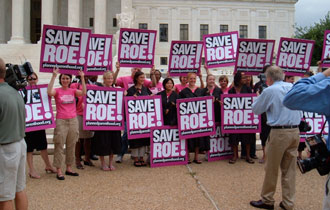 Compare that downer with Levitt’s logic, which leads to the upbeat conclusion that Roe’s expansive reading of the Bill of Rights conferred a double windfall. First, the Court’s fleshing-out of the “penumbra of privacy” adumbrated in earlier decisions created an immediate positive right for women, the control over the circumstances of reproduction. Roe’s second benefit was its unintended but no less substantial support of the negative right which lies at the very center of the social contract: the right to be free from crime.
Compare that downer with Levitt’s logic, which leads to the upbeat conclusion that Roe’s expansive reading of the Bill of Rights conferred a double windfall. First, the Court’s fleshing-out of the “penumbra of privacy” adumbrated in earlier decisions created an immediate positive right for women, the control over the circumstances of reproduction. Roe’s second benefit was its unintended but no less substantial support of the negative right which lies at the very center of the social contract: the right to be free from crime.
Lumping judges like Moore, Scalia, and Thomas under the rubric of “originalists,” it’s the expansion, or ratcheting-up of rights to accommodate the vicissitudes of society’s change over time which sends them into oxygen debt. But it’s easier to pull a priest off a preteen than to get the Right to admit that the first skirmish of what blossomed into today’s culture wars was Brown v. Board of Education: the Warren Court’s initial paradigm-shift from a mummified Constitution to a living, breathing agent of social change. To an originalist, tradition will always trump tralatition. Sure, they’ve fallen back from race to religion, converted the old venom into veneration for the saints’ bones and parchment of an imagined past, and peopled it with wig and tight-wearing Founding Father figures. But if the conferral of additional rights is really responsible for the unprecedented crime drop, it renders the contemporary impetus to curtail extant rights all the more pernicious and misguided.
A politician once told me that when she had to cry during a speech she would think about all the unborn lost to abortion. On the other hand, I nearly weep every time I think of Ashcroft’s gall-bladder surgery, reaping as he did the benefits of scientists and doctors he’d had burned in an earlier age. The only limitation of rights I could endorse would be to restrict available medical treatment to that contemporary with the tenets of one’s faith and values. Inpatient forms would ask racial views (“Oh no, sir, that’s quite alright. Everyone’s entitled to their opinion. You’ll love our pre-Brown v. Board of Education wing. What? You need a kidney transplant? Sorry, I’m afraid those are a wee bit post-1954, sir. But trust me, you’ll LOVE the food. It’s just like Johnny Rockets! How fun!”). On a sliding scale, Civil War reenactors would fare worse, but the originalists and anti-abortionists would really take it on the chin. Most likely they would end up a one-generational phenomenon. Alternately, if they survived the leeches or trepanation with rocks, they would interpret it as more irrefutable evidence of divine intervention. It’s an ancient algorithm: the bullet that barely misses the Pope’s heart is a miracle, but the tsunami which wipes out thousands is millenarian Morse code, chiliastic collateral damage. It’s a game of three-card monte you’ll never win or lose, depending on which side of the table you stand.
See what I mean? All it takes is ten minutes on one of those websites and I begin to megalomaniacally fantasize about a utopian future where everyone’s like me. I even came up with a name for this paradise: Heaven.
That’s why I stayed for approximately 1/48th of the 48 hour prayerathon. I confess, I have a difficult time distinguishing strip-malls, and after fruitlessly driving around the exurbs for an hour I was ready to abort my search for the Farm. Then I found it.
I’d wrongly imagined Spahn Ranch. This was a split-level ranch with barn. I followed the bales of hay down a long driveway and parked in a field of cars. Many had tags from midwestern or southern states. One had come from Canada. Several had vanity plates with religious messages like “SAVD” or “4JESUS.”
I walked around. A band jammed under a tent. Kids sat on the lawn reading Bibles. A few stood and swayed to the music. I didn’t recognize anyone. A girl was talking into a microphone. I couldn’t hear her over the band. She spoke for a few minutes and then passed the microphone to another girl. This girl was much louder. She talked about her relationship with God and about her father molesting her. The dancers kept swaying to the funereal beat. I expected to see a lot of finger-pointing piety, but for every face radiating smugness there were two looking just plain bored. In hindsight, it had been unrealistic for me to expect an orgy.
I wandered over to the house. Next to a tennis court sat several rows of small, empty shoes. A banner above them read “Pray for their parents.” It sort of reminded me of something. Oh right, the display at the Holocaust Museum, the room filled with thousands of shoes. Only there weren’t nearly that many here, and these shoes were new and hadn’t been worn by anyone, let alone people who’d been killed. The lawn was very well-manicured, however.
On my way back to my car I peeked inside the barn. I’d read about the Nazi Lebensborn program with its Aryan stud-farms, and I wanted to make sure that the stables weren’t filled with lustful xian women, eager to replenish the ranks of the embryos which our under-populated planet cried out for. They weren’t.
I didn’t speak to anyone. I went home.
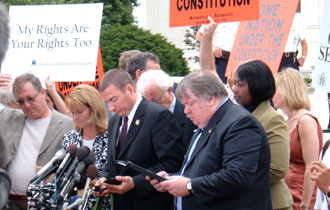 A week went by. I started following the Abramoff scandal, which was beginning to get a lot of press. His lobbying firm had taken millions from Native American-owned casinos in Mississippi to fight several proposed casinos across the line in Alabama. Emails surfaced in which Abramoff mistakenly referred to his clients as the Troglodytes, but I’m pretty sure they were the Choctaws. Regardless, Abramoff hired Ralph Reed, former-head of the Xian Coalition, who cleansed the money of its taint of sin by using it to whip-up the Alabama xians into an old-fashioned religious crusade. The Alabama casinos lost; the Choctaws won; and the righteous gloated about their victory over vice during their long drives to gamble in Mississippi.
A week went by. I started following the Abramoff scandal, which was beginning to get a lot of press. His lobbying firm had taken millions from Native American-owned casinos in Mississippi to fight several proposed casinos across the line in Alabama. Emails surfaced in which Abramoff mistakenly referred to his clients as the Troglodytes, but I’m pretty sure they were the Choctaws. Regardless, Abramoff hired Ralph Reed, former-head of the Xian Coalition, who cleansed the money of its taint of sin by using it to whip-up the Alabama xians into an old-fashioned religious crusade. The Alabama casinos lost; the Choctaws won; and the righteous gloated about their victory over vice during their long drives to gamble in Mississippi.
Suddenly it hit me.
The fight to overturn Roe was being funded by Canadian abortion clinics!
I went over the evidence: 1) The girl at the court had dropped a quarter. It was Canadian. 2) One of the cars at the farm had a license plate, also from Canada.
Woodward and Bernstein had started with less. Didn’t they? Wait, that was someone else. Yea, they had a bunch of arrests, a break-in or something.
Alright, it was a little underwhelming. Maybe I was crazy, but not crazy enough to jump to such hasty conclusions.
At least I wasn’t until the next morning, when I picked up the paper and did a spit-take with a shitake mushroom in my mouth.
O’Connor was retiring.
Ruh-Roe! One of the moderates? Not the 84-year-old guy, or the 80-year-old with cancer, but the spry 75-year-old who in Roe’s darkest hour cast the deciding vote to uphold it in Planned Parenthood v. Casey? With an abortion case on the next docket?
Reader, put a Roman numeral I, or simply the capital I of the alphabet, at the top of this story. The number 1 works as well, really. Because if this scandal didn’t just grow legs, my name’s not Wilbur Wilson, your man in Washington!
